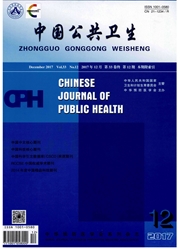

 中文摘要:
中文摘要:
目的 探讨蒙古族人群代谢综合征(MS)及其各组分与脑卒中的关系,为脑卒中的预防和控制提供科学依据。方法 于2002年6月—2003年8月采用整群抽样方法在内蒙古通辽市朝鲁吐和固日班花乡抽取2 535名≥20岁蒙古族居民进行前瞻性队列研究,并采用多因素Cox回归模型分析MS及其各组分与脑卒中发生的关系。结果 内蒙古通辽市2 535名≥20岁蒙古族人群MS、中心性肥胖、血压偏高、高甘油三酯(TG)、低高密度脂蛋白胆固醇(HDL-C)、空腹血糖(FPG)异常的患病率分别为27.50%、36.06%、50.73%、17.51%、54.00%、22.13%;蒙古族人群脑卒中累积发病率为4.73%,发病密度为520/10万人年,其中男、女性人群脑卒中的发病密度分别为832.54/10万人年和300.82/10万人年,缺血性脑卒中和出血性脑卒中的发病密度分别为329.14/10万人年和190.55/10万人年;多因素Cox回归分析结果显示,在调整了性别、年龄、吸烟、饮酒、心血管病家族史、体质指数(BMI)、总胆固醇(TC)、低密度脂蛋白胆固醇(LDL-C)、C-反应蛋白(hs CRP)等混杂因素后,随着MS组分聚集程度的增加,蒙古族人群总的脑卒中发生的危险性也随之增加(χ2=4.866,P=0.027),但缺血性卒中和出血性卒中发生的危险性差异均无统计学意义(均P〉0.05);患MS的蒙古族人群与未患MS的人群比较,发生总的脑卒中、缺血性脑卒中、出血性脑卒中的危险性差异均无统计学意义(均P〉0.05);MS各组分中,仅血压偏高与蒙古族人群总的脑卒中(HR=2.717,95%CI=1.596~4.625)、缺血性脑卒中(HR=2.084,95%CI=1.095~3.968)、出血性脑卒中(HR=4.763,95%CI=1.807~12.559)发病有关(均P〈0.05)。结论 MS与蒙古族人群脑卒中的发生无关,但血压偏高是总的脑卒中、缺血性和出血性脑卒中的重要危险因素。
 英文摘要:
英文摘要:
Objective To explore relationships between metabolic syndrome( MS) and its components and the incidence of stroke among a Mongolian population. Methods A prospective cohort study from June 2003 to July 2012 was conducted among 2 535 Mongolian residents aged 20 years and older selected with cluster sampling from Inner Mongolia. Cox proportional hazards model was employed to evaluate associations of metabolic syndrome and its components with the incidence of stroke. Results Among the participants at the base line survey,the prevalence rates were 27. 50%for MS,36. 06% for central obesity,50. 73% for high blood pressure,17. 51% for high triglyceride( TG),54. 00% for lowhigh density lipoprotein cholesterol( HDL-C),and 22. 13% for abnormal fasting blood glucose( FPG),respectively.For the participants during the followed-up,the cumulative stroke incidence was 4. 73% and the stroke incidence density was 520 /100 000 person-years( 832. 54 /100 000 person-years in the males and 300. 82 /100 000 person-years in the females); the incidence density of ischemic stroke and hemorrhagic stroke were 329. 14 /100 000 person-years and 190. 55 /100 000 person-years. Multivariate Cox regression analysis showed that after adjusting for gender,age,smoking,alcohol drinking and familial cardiovascular disease history,body mass index( BMI),total cholesterol( TC),lowdensity lipoprotein,high-sensitivity C-reactive protein,and other confounding factors,the total stoke risk increased with the number of MS components( χ2= 4. 866,P = 0. 027),however,the increased risk was not observed in separated analysis for ischemic and hemorrhagic stroke( both P〉0. 05). For all the MS components,only high blood pressure was associated with increased risk of stroke incident among the participants,with the hazard ratio( 95% confidence interval) of 2. 717( 1. 596- 4. 625)for total stroke,2. 084( 1. 095- 3. 968) for ischemic stroke,and 4. 763( 1. 807- 12. 559) for hemorrhagic stroke,respectively. Conclusion
 同期刊论文项目
同期刊论文项目
 同项目期刊论文
同项目期刊论文
 Association of obesity and biomarkers of inflammation and endothelial dysfunction in adults in Inner
Association of obesity and biomarkers of inflammation and endothelial dysfunction in adults in Inner Association of elevated inflammatory and endothelial biomarkers with prehypertension among Mongolian
Association of elevated inflammatory and endothelial biomarkers with prehypertension among Mongolian Biomarkers of inflammation, endothelial dysfunction and insulin resistance in adults of Inner Mongol
Biomarkers of inflammation, endothelial dysfunction and insulin resistance in adults of Inner Mongol Relationship between white blood cell count at admission and short term outcome in patients with acu
Relationship between white blood cell count at admission and short term outcome in patients with acu Biomarkers of inflammation and endothelial dysfunction and risk of hypertension among Inner Mongolia
Biomarkers of inflammation and endothelial dysfunction and risk of hypertension among Inner Mongolia 期刊信息
期刊信息
